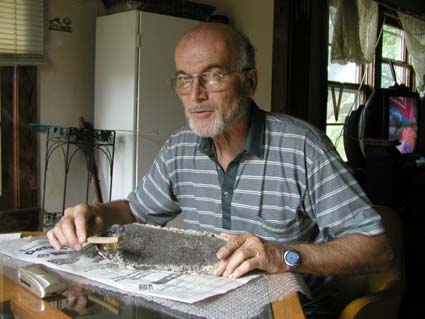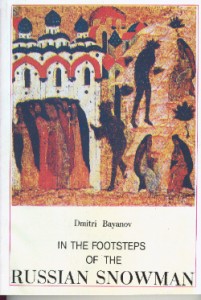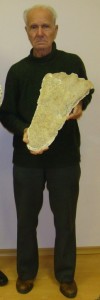Russians Coined “Patty”???
Posted by: Loren Coleman on April 16th, 2011
As I have noted in various of my writings and talks, “The in-crowd of Bigfootery call the Patterson-Gimlin Bigfoot by the nickname ‘Patty.'”
During the Sasquatch Summit, with Bob Gimlin, John Green, and nearly 300 Bigfoot conference attendees looking on and listening, a Russian researcher made an amazing claim.

Igor Burtsev, famed for his Pamir and Siberian Snowman studies, said that the Russians had invented, coined, and were the first to name the Sasquatch in the Patterson-Gimlin footage as “Patty.”
As the crowd rumbled, mumbled, and growled, Burtsev gave no source, no date and no verification for this astonishing bit of news to the assembled.

One of the on-going jokes of the Cold War was that the Russians always said they were first in everything. They allegedly were the first ones to invent the television. The first ones in space. Indeed, the Russians did send the first cat, first dog, first man, and first woman into space. But the Americans were the first with a man to the moon.

Were the Russians the first to call the Bigfoot in the Patterson-Gimlin 1967 footage by the name “Patty”?
Does anyone have any records of the first or earliest usage of “Patty”?

This is an important historical point of order that cries out for further investigative insights. 🙂

What are the facts? Were the Russian the ones who “named” it?

About Loren Coleman
Loren Coleman is one of the world’s leading cryptozoologists, some say “the” leading living cryptozoologist. Certainly, he is acknowledged as the current living American researcher and writer who has most popularized cryptozoology in the late 20th and early 21st centuries.
Starting his fieldwork and investigations in 1960, after traveling and trekking extensively in pursuit of cryptozoological mysteries, Coleman began writing to share his experiences in 1969. An honorary member of Ivan T. Sanderson’s Society for the Investigation of the Unexplained in the 1970s, Coleman has been bestowed with similar honorary memberships of the North Idaho College Cryptozoology Club in 1983, and in subsequent years, that of the British Columbia Scientific Cryptozoology Club, CryptoSafari International, and other international organizations. He was also a Life Member and Benefactor of the International Society of Cryptozoology (now-defunct).
Loren Coleman’s daily blog, as a member of the Cryptomundo Team, served as an ongoing avenue of communication for the ever-growing body of cryptozoo news from 2005 through 2013. He returned as an infrequent contributor beginning Halloween week of 2015.
Coleman is the founder in 2003, and current director of the International Cryptozoology Museum in Portland, Maine.










Mmm, according to the story Igor was telling as Tom Yamarone got out the hook [during his Sasquatch Summit presentation], he was also the first to have Sasquatch leave footprints in the basement [in Tennessee?] and receive a silver necklace with a lovely pendant as a gift from his Sasquatch friends.
What’s next? Sas selling arts and crafts at the flea market?
“The first ones in space. Indeed, the Russians did send the first cat, first dog, first man, and first woman into space. But the Americans were the first with a man to the moon.”
That’s great and all, but the Russians weren’t trying to land a man on the moon, were they? The idea that you yanks were racing the Russians to put a fellow on the moon is pure propaganda.
The television’s evolution is quite complex, but if a Russian did invent it, you can be sure it was an American who dreamt up the idea of using it to transmit limitless hours of utter dross on the airwaves.
Ah, here’s another list of Russian space firsts.
As a space historian, I run into this a lot. I always appreciated Gene Roddenberry’s joke in making Ensign Chekov an over-the-top partisan – the Russians had done everything first, better, or both.
Every nation likes to boast of its accomplishments, and some nations are more determined than others. Space is a field where many “firsts” really did belong to Russians, so of course it was heavily played up in the Cold War days.
There was a moon race, but the Soviet effort was crippled by the death of brilliant organizer/engineer Sergei Korolev. When Apollo succeeded, the Soviets gave it up and claimed they had never been focused on the moon, which most Americans accepted until hardware like the Soviet lunar lander began turning up in the post-USSR period.
The Soviets since early days trumpeted examples of science and technology achievements. The father of space flight, Tsiolkovsky, was a little-known mathematics teacher until the new government realized he was a true pioneer, promoted his reputation and his books, and gave him a comfortable pension. When they could not find a true Soviet first in some area, they tended to exaggerate or fabricate one. I own an English-language version of a Russian aeronautics textbook that credits the first manned aircraft to a Soviet naval officer – the Wright brothers do not even get a mention.
Sometimes this mindset led to disastrous embraces of Russian ideas that actually were no good, with Lysenko being the standout example.
I have no idea about the Patty claim – certainly I never heard it before now. But it’s a reminder that history is a fragile thing, even when events are still within living memory. Universally agreed-on narratives are rare. We fallible humans must do our best.
As Star Trek’s Chekov would say (about anything), “it was invented by a little old lady from Leningrad”.
The Russians also had some not so great firsts in the space programs also.
First fatality in space training mission
1961 March 23 – Valentin Bondarenko
First Fatality in a Space Flight.
1967 April 24 – Soyuz 1 – Vladimir Komarov
1971 June 30 – Soyuz 11 –
Vladislav Volkov
Viktor Patsayev
Georgi Dobrovolski
They seem to play those facts down a bit though.
To get back on topic, this is nothing really new. In Dmitri Bayanov’s 1997 book he writes (regarding the earliest days of Bayanov’s and Burtsev’s PGF analysis/research in the early 1970s):
For what it’s worth, I don’t think Dmitri Bayanov is telling lies, seeing as the Soviets WERE amongst the first people to properly study the footage. John Green certainly wasn’t calling the PGF creature ‘Patty’ in his early books. Green was writing “the Patterson creature/the creature/the sasquatch”.
I’m pretty convinced that it WAS the Soviets who first coined the term “Patty”.
No need to dispute their claim.
No disputing the claim, per se, but I was looking for a citation, a date, and/or an instance where the Russians vs anyone else has used “Patty” first.
Thank you, Kopite.
Ah sorry Loren.
I don’t have any specifc date only that the term Patty was coined when the Russians were first analysing the footage in the early 1970s.
I do have Myra Shackley’s book from 1983 about Wildmen and she says the PGF creature is “nicknamed ‘Patti”. Different spelling but possibly seeing as she delved into Soviet wildmen she may have picked it up via correspondence with Bayanov/Burtsev.
Well, the Russians, if you believe them, invented “beizbol” too. Not sure about “fuzbol,” but you can bet that invention is documented in a Russian archive somewhere. Along with “pazsta.”
This one I can believe, though. There is an odd romantic sentimentality in how the Russian hominologists discuss the Patterson creature – and other hairy hominoids – that makes it eminently believable.
And it is true that Russians – and a Brit or two for that matter – were well ahead of Americans in critical analysis of the Patterson film.